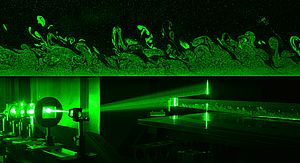| Topics in multiphase flow simulations using the Lattice Boltzmann Method | num | Download |
|
| Synthetic data generator | exp | Download |
|
| Numerische Analyse partikelbeladener turbulenter Strömungen | num | Download |
Fast alle Strömungen, die in der Umwelt und Technik vorkommen, sind turbulent. Jedoch ist bereits die numerische Simulation einphasiger turbulenter Strömungen aufwendig, wobei es viele erfolgreiche Modellierungsansätze gibt. Eine noch größere Herausforderung besteht hingegen in der numerischen Analyse partikelbeladener turbulenter Strömungen. Trotz ihrer hohen Relevanz in Umwelt und Technik, sind vorhandene Modelle nur für vereinfachte Bedingungen gültig und eine Validierung steht oft noch aus. Ein wichtiger Anwendungsfall ist die numerische Auslegung einer Biomasse-Brennkammer. Dabei ist die Bestimmung der Aufheizraten, der Dynamik, und der turbulenten Durchmischung nicht-sphärischer Partikel entscheidend um den gesamten Verbrennungsprozess zuverlässig auszulegen.
Die Generierung von hoch-aufgelösten Referenzdaten mit Hilfe von Simulationen und die Entwicklung von genauen Modellen für Anwender, sowie deren Validierung sind aktuelle Forschungsvorhaben, die am Aerodynamischen Institut intensiv verfolgt werden. Für dieses Projekt sind wir auf der Suche nach motivierten Masterarbeitern. |
| Aeroacoustic simulation of moving rigid bodies via lattice Boltzmann method | num | Download |
The lattice Boltzmann method features good parallelization properties as well as low dissipation and dispersion errors making it suitable for computing the turbulent flow as well as the acoustic far field at once.
In the case of a rotor-wing configuration there is no frame of reference in which neither the wing nor the rotor do not move relatively. Hence, additional challenges arise from treating the boundary condition of the solid surface traveling across the computational grid, e.g., refilling emerging cells without introducing spurious noise in performance wise efficient manner.
This thesis builds up on foregoing work evaluating different refilling schemes for academic two-dimensional flow cases. The most promising one will be chosen and extended to three dimension.
Here, performance optimization from algorithmic as well as from implementation point view are essential to apply the methodology to validation cases from the literature. |
| Erweiterung der Lattice-Boltzmann-Methode auf kompressible Strömungen | num | Download |
|
| Machine learning-based prediction of forces in Lagrangian point-particle approaches | num | Download |
Particle laden turbulent flows play an import-
ant role in many technical fields such as drug de-
position in human airways, or the combustion of
solid biofuels. To simulate these problems, two dif-
ferent approaches are available: The fully resol-
ved direct numerical simulation (DNS), where all
features of the flow field including the surface
of the particles are resolved, and the Lagrangian
point-particle approach, where empirical models
are used to determine the forces acting on each
particle. Due to the high computational costs of
the DNS approach, reduced order point-particle
models are indispensable for the simulation of lar-
ge scale technical applications. These models pro-
duce good results for very small particles but lead
to significant errors for larger ones.
In this thesis, data from a DNS will be used
to train an artificial neural network (ANN) which
predicts the forces acting on a particle in a reduced
order point-particle model. In a first step, fully re-
solved simulations with many particles have to be
performed to extract the local flow field and force
data for each particle, resulting in a large databa-
se for the determination of new point-particle mo-
dels. In the second stage, the ANN is trained based
on this database, where velocity data from a par-
ticle’s surrounding flow field function as input, the
acting force as output, and the acting forces from
the DNS as ground truth. In a final step, it is inve-
stigated how transfer learning improves the pre-
dictive capabilities of the ANN. That is, the ANN
is pre-trained with ground truth data from empi-
rical drag laws, and the highly resolved data from
the DNS are employed solely in the final training
iterations. |
| Machine learning-based modeling of non-equilibrium chemical reaction rates for the computation of hydrogen-air flames | num | Download |
Hydrogen combustion is shaping to be an im- portant component for the future of electricity grids based on renewable energies. Combustion si- mulations solve the mass, momentum and energy equations in addition to equations describing the reaction kinetics and transport of species. The- se additional equations are, in general, expensive to solve when compared to the non-reacting flow equations.
In order to reduce computational expense, some simplified alternatives exist, like skeletal reaction mechanisms or two-step chemistry. If one desires to use the complete, relevant reaction chain, tabu- lated chemistry or machine learning models are a good alternative and a good compromise between accuracy and efficiency. In this context, four ty- pes of machine learning algorithms are employed. The first algorithm maps each location in the high- dimensional flow domain to a low-dimensional sub- space. With the second algorithm, representations in the low-dimensional subspace are clustered into regions of different thermochemical equilibrium. A classifier is then trained to classify new points into
You ...
these regions. Finally, reaction kinetics and trans- port species are learned for each cluster by artificial neural networks.
The main tasks of the thesis are to (1) im- plement the proposed machine learning-based me- thod, and (2) compare the accuracy and speed of the proposed method compared to solving the re- acting flow equations, chemical kinetics and trans- port phenomena directly. |
| Numerical analysis of control of shock-wave / boundary layer interaction using air-jet vortex-generator | exp | Download |
|
| Multiphysics simulations with applications to aeroacoustics | num | Download |
|
| Injection and Turbulent Mixture Formation of Bio-Hybrid Fuels in Internal Combustion Engines | num | Download |
|
| Active drag reduction in turbulent boundary layer flows subjected to spanwise traveling transversal surface waves using learning-enhanced CFD | num | Download |
|
| Thermoacoustic Investigations of Hydrogen-Air Flames | num | Download |
|
| Researching the multiphase flows of the Precise Electrochemical Machining (PECM) process | num | Download |
|



